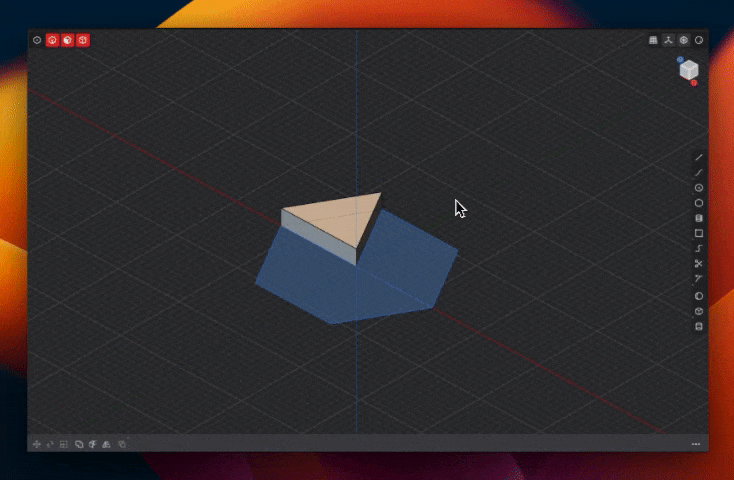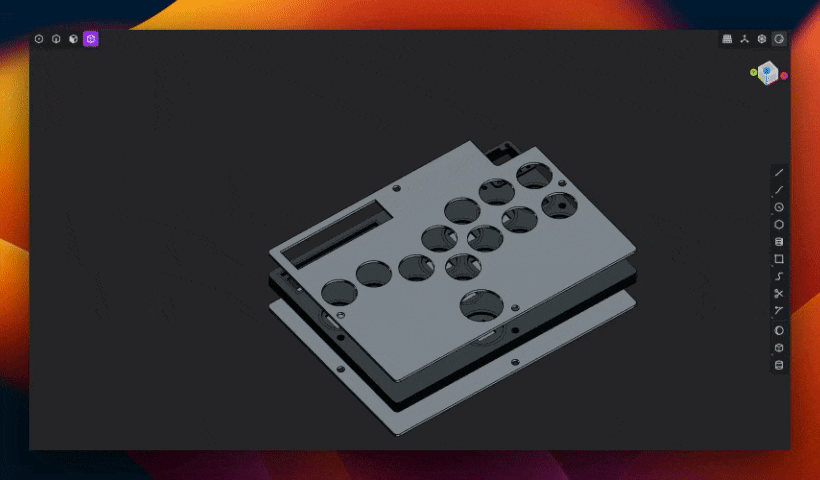I have long wondered what a "simple" CAD program would look like. The idea seemed almost paradoxical to me. I was used to AutoCAD with its menus upon menus of functionality. Programs like these are undoubtably powerful, but I could only ever I say I used maybe 20% of what AutoCAD can do.
Fun fact: I studied engineering for a while in college and used AutoCAD to model a mobility cart for a paraplegic goat. I even fabricated the cart myself through many long nights in a machine shop.

Subsequent students improved on my design to make it more rugged to deal with all the conditions of farm life (mainly lots and lots of mud), but I was still quite proud. After leaving my partial engineering education behind though, CAD just didn't fit into my life very much. I still liked modeling, but AutoCAD was simultaneously far too capable for my occasional hobbyist project and was moving to a pricing scheme that was completely out of reach for me, so I fell out of touch with it.
Recently, I had an idea that I really wanted to model out. I looked at AutoCAD, and it now costs over $2000 to use for a year. That wasn't happening. I did try out Fusion, which is similar and can be used for free after jumping through some hoops, but it has this clunky cloud integration that I don't like, and it just wasn't feeling right to me.
I also tried Tinkercad, and I liked that well enough for sketching out concepts, but I didn't feel like making a real, full-fledged design in it made much sense. So, I decided to look around at other options.
Enter Plasticity.
Plasticity bills itself as "CAD for artists". I dabble in art at best, but I was intrigued by the concept nonetheless. I imagined a somewhat stripped down version of AutoCAD that was easier to navigate and felt snappier.
That's more or less exactly what I got. Where AutoCAD wants to drown you in menus and toolbars, Plasticity only wants you to focus on a single tool at a time. Everything in Plasticity is context-sensitive. Here I've made a sketch, and I want to extrude it. There is no obvious extrude button (it is there at the bottom, but it's tiny). Instead, I click on the face I want to extrude, and Plasticity goes right into that.

Now if I want to add a fillet to this thing, I just click on the corners. Dragging one way gives me a fillet, and the other way gives me a chamfer.

In many ways, Plasticity is the CAD program I have always imagined. It's not quite as powerful as AutoCAD, but I don't need it to be. I also love the pricing: a flat fee for a year of updates, and you don't lose access if you don't renew. It's refreshingly simple and fair amidst other CAD programs that charge ridiculous fees.
I don't want to give the impression that Plasticity is absolutely perfect, though. I like it a lot, but I did run into a few bugs. There is also always a danger with products that lean on intuition that your intuition is not necessarily the designer's intuition, which can be frustrating.
That said, there are a wealth of Plasticity tutorials out there, so when I did run into something that didn't make sense, I watched someone else do it, and then it did. There is a bit of learning the "Plasticity way" that you have to do, but this is true of any CAD program.
With AutoCAD, learning was purely utilitarian. Even though Plasticity doesn't have quite the depth of AutoCAD, I know there's still a lot about it I haven't explored, and most importantly, I'm excited by that.
Here's a look at an arcade controller I'm working on as a fun personal project:

The Surprise
The software you use can inspire you.
Through trial and error, I figured out what buttons to push in AutoCAD, but I don't know that I would say I really understood it. The names of tools just didn't stick with me. I had to click through menus to remind myself of my options regularly. The fun of AutoCAD was seeing the result of my work.
I bounced off Plasticity when I first tried to use it — I was used to the menus upon menus. How was I supposed to make a chamfer when there's no chamfer button three menus deep?!
After a couple of weeks I came back with a clearer head, watched some basic tutorials, and started fresh. It all started to make sense. It wasn't about what tool I wanted to use, but it was about what part of the model I wanted to affect, and right tool would follow. It's much more like sculpting but with CAD tools. Using Plasticity itself actually feels fun, not something I would often say of AutoCAD.
Plasticity reignited my passion for modeling. I only intended to use it for one simple thing, but I already dove into another project, and I have a few more in mind. I can safely say Plasticity is my CAD program of choice for the moment, and I'm looking forward to seeing what comes next for it.


